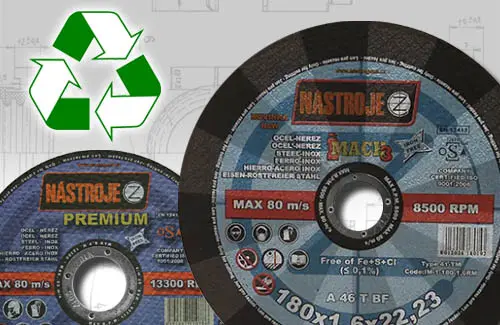The regular price is the current manufacturer's recommended price! FREE shipping for orders over EUR 41,67 within CZ+SK (PPLparcel)

Since the discs are made up of several layers, it is important to remember them so that the discs can be recycled correctly:
The main ingredient is an abrasive - silicon carbide or aluminum oxide + a liquid/powder resin that is used to bond the components of the mixture with a reinforced mesh + fillers - calcium carbonate, pyrite, potassium aluminum fluoride, etc. – used to join the discs + glass fabric to reinforce the discs + metal inserts + label.
First, let's look at the main reasons for recycling discs:
- reduction of waste and environmental pollution - for discs located in landfills, as a result of decomposition, embedded abrasives are released, which contaminate the soil and groundwater
- recycling helps to reuse valuable materials such as metals, glass fibers, plastics, abrasives
- reduction of production costs – the repeated use of recycled materials will also significantly reduce the costs of producing new discs
- increasing the general awareness of recycling in the general population
And what about recycling itself?
Manufacturers state that regional and national regulations must be followed. The discs are classified as other/mixed waste, not classified as hazardous waste if the abrasive contains no hazardous materials. The recommended disposal code is 120121 – used abrasive tools and abrasive materials.
According to the decree of the Ministry of the Environment, from 2030 it will be forbidden to put discs in landfills, because it is possible to recycle them effectively under the current state of scientific and technical progress.
It is therefore advisable to find a suitable recycling company to assess the suitable recycling method. In some cities, it is possible to take this waste to a collection yard, or this waste is exported directly by technical services.
Recycling methods:
- pyrometallurgical recycling – melting of materials at high temperatures
- hydrometallurgical recycling – dissolution and precipitation of materials using aqueous chemistry
- mechanical recycling – separation of disc materials based on differences in physical properties
- material flow isolation – dissolution of target materials from discs
When choosing the most suitable recycling method, the composition of the discs is especially important - the material mix determines the appropriate separation techniques. For example, smelting is best suited for wheels with steel, while hydrometallurgy works best for wheels with a diverse mix of materials.

Other articles:
Brusné kotouče CerMax
Diamantový řezný kotouč: jak vybrat ten správný?
Brusné a řezné kotouče
Svinovací metry